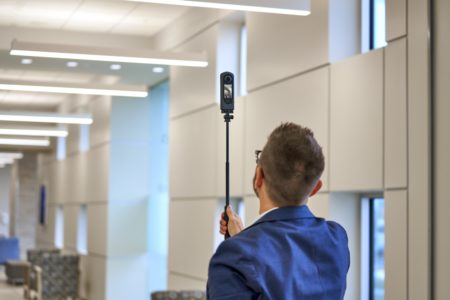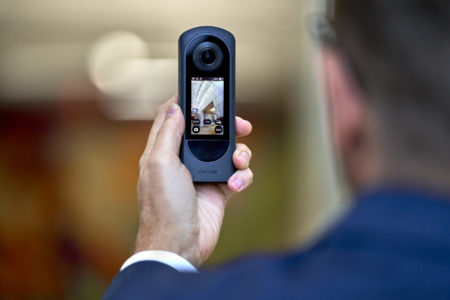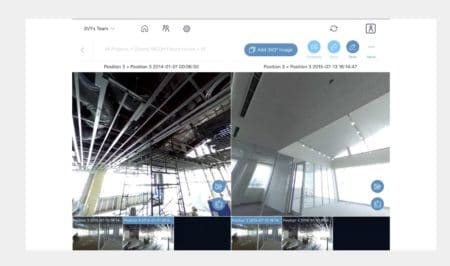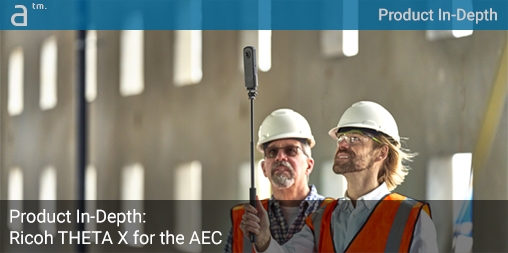THE RICOH THETA SERIES OF 360-DEGREE CAMERAS feature innovative design and broad application of uses. In this Product In-Depth, we will focus on the THETA X model and its potential benefits in the AEC/O industry.
Architects, engineers, contractors, and building owners have many photography needs. These extend from photo-documenting existing buildings before new renovations or additions to using photographs during building construction phases to substitute for and complement site visits by architects, engineers, and building owners.
Photography Challenges in AEC
Photography has always played a pivotal role in the building industry. One of its most important uses has been in photo-documenting existing buildings before their renovations and also prior to their demolition. Historic structures, in particular, must be carefully documented with photography. When the devastating 2019 fire broke out in Paris at the Notre Dame Cathedral, those charged with its massive reconstruction relied upon extensive documentation of what was once there but now needed to be reconstructed.

The RICOH THETA X is the newest member of the THETA camera line and can shoot advanced 360-degree spherical panorama images in high resolution. The unit can mount on a tripod. Its companion software for smartphones enables remote shutter control as well. (click to enlarge)
Even buildings far less critical than France’s most famous cathedral face common disasters like fires or earthquakes and require reconstruction. Having photographed a building extensively is quite an endeavor. One challenge is missing information on parts of a building that turn out critical but were never captured in a photograph. The limitations of traditional photography center on the need to take hundreds of images with appropriate overlaps and dozens of recentering to make sure every part of a building’s environment is captured.
This is where RICOH THETA X’s camera solves problems. The THETA X is an advanced 360-degree dual-lens spherical camera. With just one click in the center of a room, the entire room is captured in a 360-degree spherical image.
MORE: Architosh & RICOH THETA X Webinar: Digitizing the job site with 360-degree images (Sign-Up!) (or view on Architosh’s Vimeo channel)
Architects, in particular, when visiting job sites, are typically over-tasked with on-site responsibilities, often leaving them tight schedules to photo document construction activities. Typically, architects arrive on-site and go directly into meetings or walk-through sessions with construction and owner teams. Then they take photos after they meet with the remaining time they have. The THETA X can save architects (and contractors and engineers) lots of time by covering far more of the building in less time than, per se, the architect’s iPhone.
Another thing that gets missed in on-site photography is the ground plane and the ceiling plane. This is where 360-degree photography helps address this often-overlooked coverage.
THETA X — In Detail
The THETA X is a multi-purpose camera able to shoot still images, 360-degree spherical images, and video. Still images can be captured in 11k or 5.5k size (11,008 x 5504 or 5504 x 2752 pixels). Videos range from 5.7k to 2k in 30-60 fps. And you can live-stream (via USB) in 4K format at 30 fps for up to 25 minutes. By updating to the latest camera firmware, 2K format can live stream for up to 24 hours. Depending on the format size, you can shoot up to 220 images under one battery charge or generate 30 – 55 minutes of video. Video time per recording is up to 25 minutes for 4K at 30 fps.

This close-up image shows the 2.25-inch LCD screen which is a unique feature of the RICOH THETA X model. The user interface works with swipe gestures to navigate around the camera’s controls. Both Wi-Fi and Bluetooth form connectivity of the camera to computers and smartphones and the unit ships with a USB-C cable for battery charging and data transport.
The THETA X comes with plenty of internal memory. At 46 GB, it can hold up to 11,500 still images in the 5.5k format or 4,600 photographs in the 11k format. There is also a microSDXC memory card slot on the unit. Most users in AEC/O will be transporting their photography to project directories on the LANs, cloud storage, or CDE (common data environment) software systems as a matter of standard protocol. Still, it is nice to know you can store many images in the unit’s internal memory.
Users can upload their work to the theta360.com website, dedicated to sharing 360-degree images. This public site might be workable for some AEC/O users, while others will want to share with clients and colleagues with more controlled access. There is the ability to link to various cloud services dedicated to or supporting 360-degree images, such as the virtual tour service, RICOH360 Tours.
RICOH360 Tours lets users share and set up a virtual tour of an environment, ideal for real estate and property management or facilities professionals. This same offering can also be of benefit to architects. RICOH360 Tours enables the embedded tours into existing websites like an architecture practice’s website. (see this Tours example).
Reality Capture in AEC
RICOH360 Projects is similar to its Tours offering but is oriented directly at the building industry. This is a next-generation all-in-one reality capture and communication platform that digitizes the job site. This system mainly links your 360-degree photographic output to drawings (floor plans) for remote off-site monitoring.

The RICOH THETA X camera works best for AEC/O professionals when paired with Ricoh360 Projects, a dedicated cloud-based software system for construction professionals.
This system lets you compare 360-degree spherical photography taken over time, with date and time stamps data fully displayed. You can even use basic markup tools over these images in RICOH360 Projects to collaborate with project stakeholders and colleagues.

RICOH360 Projects lets construction professionals remotely monitor construction projects via 360-degree images. Images are time and date-stamped. The software allows the side-by-side comparison of images. As you rotate in one of the images both images rotate at the same time—allowing AEC pros to review what things looked like on the construction site at various stages of the construction schedule.
Architosh will take a deeper look at RICOH360 Projects and use cases utilizing 360-degree technology in a separate report soon.
THETA X Explored
RICOH has several software applications that conjoin with the product line’s THETA X and other THETA units. There are apps for the desktop (Mac and Windows) and apps for your smartphone (Android and iOS).
The THETA X, like all THETA units, supports tripod mounting, so you can position yourself directly in the room where you want to shoot and take yourself out of the image by shooting remotely using the app on your smartphone.
There are actually two different apps for the smartphone. THETA+ is for photo and video editing, social media sharing, animations, time-lapse creation, and picture-in-picture generation. The RICOH THETA app is for remote shooting and unit management and also can manage and share images, including to social accounts.
MORE: Architosh & RICOH THETA X Webinar: Digitizing the job site with 360-degree images (Sign-Up!) (or view on Architosh’s Vimeo channel)
The THETA X has a built-in GPS and A-GPS for accurate position information embedded into 360-degree photos. This data could be helpful for AEC/O industry apps that ingest photos and locate them on drawings of the building or project site. However, RICOH360 Project and RICOH360 Tours do not as of yet support GPS data.
We just mentioned “animations” a few paragraphs ago. If you are wondering what we mean by that, the THETA+ app can create an animation experience of a 360-degree pano. Why would you want to do this? You would want to make an animation of a 360-degree pano experience for web and social media platforms that do not support embedded panos, like Instagram. You may also want to include animated panos in PowerPoint and Keynote presentations.
THETA Models
We have discussed the THETA X unit in this article because it is the newest unit in the product line and includes a 2.25-inch TFT color LCD screen with an auto-brightness adjustment function. Ricoh has been developing this product line since 2013’s release of the THETA m15. There are now seven THETA models in the lineup, including the flagship model, the THETA Z1. The primary differences between units are image size (resolution), internal memory capacity, and battery performance. The THETA Z1 features raw format function plus a 1-inch sensor ideal for low light conditions. Thus this camera is the premium model.

While the THETA Z1 is the premium flagship model, the latest THETA X unit uniquely features the large 2.25-inch TFT color LCD screen and touch interface that any iPhone or Android smartphone user will be instantly familiar with. Small and lightweight and with a protective case, the unit can easily slip into a briefcase, coat pocket, or purse for great portability.
The units have microphones to record audio into your videos. The first units were monaural, while the Z1 unit has 4channel audio. Interestingly, the THETA X is also monaural. Again, the THETA X is the only unit with a large LCD screen. The units also support wireless and Bluetooth, but the connections vary. The THETA X supports Bluetooth and wireless LAN connection. Each THETA device comes with a USB cable to connect to your computer, used for charging the unit’s battery and data transfer.
Final Thoughts
Another thing to mention about the THETA X is its ability to generate HDR images (HDRI). These 360-degree HDR images are used as background images in rendering software applications. HDRI is created by mixing or blending several images of the same scene with different exposures, storing the RGB color values with floating-point precision. Notably, the brightness is recorded in each pixel. This brightness data generates the light from HDR images in rendering software programs.
Advertisement
The THETA Z1 and SC2 models also have HDR shooting functions but the HDR image of the THETA X model has more natural and accurate color qualities, which are better suited for rendering backgrounds as well as interior scenes on virtual tours.
Now we see that for the AEC/O market, architects especially have another valuable use case for the RICOH THETA X camera. One can use it to take site photos in 360-degree spherical panorama as HDRI that can be used to render HDR backgrounds for architectural rendering software. Not only does the THETA X capture the actual site conditions but also its real-world light data.
To summarize, the THETA X is the latest unit in RICOH’s popular THETA camera product line. While the cameras can be used purely for fun and entertainment, the THETAs have been built with professional utility in mind. RICOH is especially focused on the building industry, where spherical images can be shot by hand or by tripod (using your smartphone as the remote shutter) and serve to economize processes on the job site that is today managed with conventional photography.
AEC/O users can save time in processes such as field surveys, progress site reports, resolving site conditions remotely, and construction progress scheduling.
Architosh will be publishing a real-world case study article on the RICOH THETA X in the near future, but this article gives you an in-depth view of what the THETA X can do today. For more information, visit theta360.com.
Join Webinar
To learn even more about the Ricoh THETA X camera system and Ricoh360 Projects for AEC workflows, sign-up for our free webinar (live or on-demand). (or here at Vimeo)
Learn how the THETA X can work with Matterport and hear from a panel of architects and builders about the importance of photography on the construction job site and how 360-degree images solve a multitude of challenges when incorporated into other digital workflows and systems.




Reader Comments
Comments for this story are closed